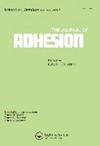温度敏感的贻贝柠檬酸盐基低膨胀组织粘合剂
IF 2.3
4区 材料科学
Q2 ENGINEERING, CHEMICAL
引用次数: 1
摘要
以贻贝为灵感的组织粘接剂由于其优异的水下粘附性,近年来得到了广泛的研究。我们最近的研究以柠檬酸、多巴胺、1,8-辛二醇和聚环氧乙烷(PEO)为原料合成了一系列的组织胶粘剂,发现两亲性胶粘剂具有高效的水下粘附机制。聚(环氧丙烷)-聚(环氧乙烷)嵌段共聚物(PEO-PPO-PEO)是一种热敏性两亲性材料,广泛应用于医疗领域。在此,我们用PEO- ppo -PEO取代PEO,将温度敏感性引入胶粘剂中,并利用PEO- ppo -PEO的亲疏水转变来减少人体温度下的膨胀。幸运的是,我们得到了积极的结果,所有合成的粘合剂都表现出明显的温度敏感性。高浓度未固化胶粘剂分散体从低温到室温的转变使其具有潜在的注射性。交联后,从4℃到37℃,固化胶粘剂的溶胀率明显降低。37℃下的溶胀率均较低,为8.4% ~ 22.5%。在湿猪皮上的粘接强度为29.2 ~ 67.1 kPa,高于市购纤维蛋白胶(9 ~ 15 kPa)。通过选择不同的(PEO)y(PPO)x(PEO)y,可以得到具有广泛力学性能的胶粘剂,拓宽了胶粘剂的使用范围。本文章由计算机程序翻译,如有差异,请以英文原文为准。
Temperature-sensitive mussel-inspired citrate-based tissue adhesives with low-swelling
ABSTRACT Mussel-inspired tissue adhesives have been widely studied in recent years because of their excellent underwater adhesion. Our recent study has synthesized a series of tissue adhesives with citric acid, dopamine, 1,8-octanediol and poly(ethylene oxide) (PEO), and found that amphiphilic adhesives showed an efficient underwater adhesion mechanism. Poly(propylene oxide)-poly(ethylene oxide) block copolymer (PEO-PPO-PEO) is a thermosensitive amphiphilic material, widely used in medical field. Herein, we replaced PEO with PEO-PPO-PEO to introduce temperature-sensitivity into adhesives, and utilized the hydrophilic-to-hydrophobic transition of PEO-PPO-PEO to reduce the swelling at human temperature. Fortunately, we got positive results that all the synthetized adhesives showed obvious temperature-sensitivity. The transition from low temperature to room temperature of the high concentrated uncured adhesive dispersion made it potentially injectable. After crosslinking, the swelling ratio of cured adhesives showed a significant decrease from 4°C to 37°C. And all the swelling ratios under 37°C were low, ranging from 8.4% to 22.5%. Additionally, the lap-shear adhesion strength on wet porcine skin was in the range of 29.2–67.1 kPa, which was higher than that of commercial fibrin glue (9–15 kPa). By selecting different (PEO)y(PPO)x(PEO)y, we could obtain adhesives with wide mechanical properties and broaden the scope of use of the adhesives.
求助全文
通过发布文献求助,成功后即可免费获取论文全文。
去求助
来源期刊

Journal of Adhesion
工程技术-材料科学:综合
CiteScore
5.30
自引率
9.10%
发文量
55
审稿时长
1 months
期刊介绍:
The Journal of Adhesion is dedicated to perpetuating understanding of the phenomenon of adhesion and its practical applications. The art of adhesion is maturing into a science that requires a broad, coordinated interdisciplinary effort to help illuminate its complex nature and numerous manifestations.
 求助内容:
求助内容: 应助结果提醒方式:
应助结果提醒方式:


